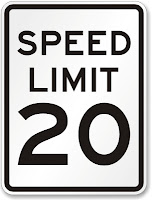A trend that has been developing in Europe and is just
beginning here in the US, is 20 mph
streets. Typically, 25 MPH is the
default minimum – often reserved for residential roads, but based largely on the design speed that the roadway was
designed for. Somerset, MD, a small lovely residential hamlet in Montgomery
County, has made a policy decision to reduce the speed limit for the entire
town to 20 MPH.
This decision was not an engineering one (which typically deals with only the safety of drivers that are already pretty safe wrapped up in a 3000 lb steel box). Rather, it was a decision based on planning for slower roads and roads that are safer for all users (children, joggers, cyclists, etc.).
Some of the the positives and negatives of a slower Main Street are:
Positives:
· Slower speeds making walking more comfortable
for pedestrians.
· Slower speeds are better for bikers (speed
differential between cars and bike is a main factor in bicycling level of
comfort and broadening its appeal to more users.
· A pedestrian getting hit at 25 mph has 4-fold
higher likelihood of dyeing than at 20 mph.
· Slower drivers are more apt to see the types of
businesses that line Main Street.
· There is simply no engineering reason to
allow/encourage 25mph speeds on Main Street, but there are certainly economic
and safety reasons for lowering the speed limit.
Negatives:
·
A driver will need an extra 23 seconds to travel
the main retail stretch from MD 216 to US 1.
That’s it. On the surface, relying on planning and policy, rather than what a
roadway could handle, sure seems to be a better way
for towns to assign speed limits.
























